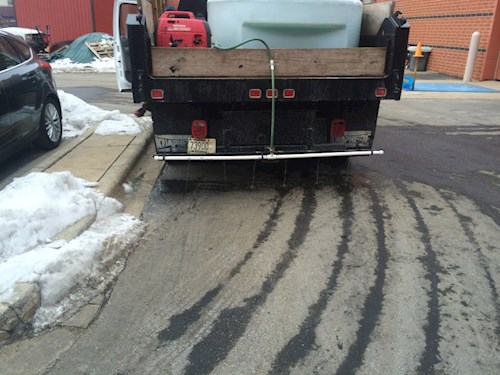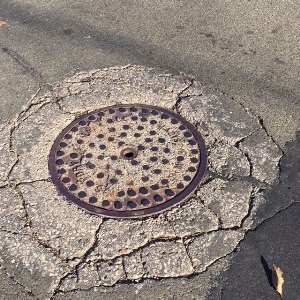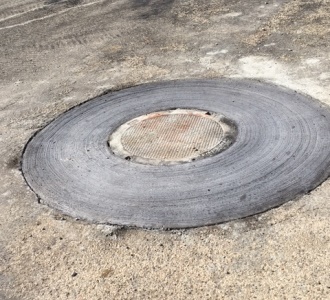Success Stories
Many winter maintenance professionals are taking action to reduce their salt use while maintaining public safety. Check out the case studies below to learn what actions others have taken and their results. If you are a municipal representative or winter maintenance professional interested in taking action and reducing salt in your community, you can learn more about each project using the contact information provided.
Walk-Behind Brushes Review
Maintaining miles of sidewalk, driveways and steps for hundreds of apartment buildings is a big job! JK Rock's Maintenance team purchased walk-behind brushes and found that the new equipment helped keep a neat, clean area and reduced salt use. The brooms got closer to the pavement than the snow blower, although they proved tricky when it came to handling.
Salt savings: 60% reduction over the course of the 2020-2021 winter.
Wisconsin Department of Transportation (WisDOT)
The price for granular salt has grown 167 percent over the past 20 years. WisDOT is taking steps to reduce the need for salt by increasing the use of liquid brine. Brine is proving to be a cost-saver with no compromise to public safety. When mixed into liquid form, $1,000 worth of salt can safely clear 224 lane miles compared to 86 lanes miles in granular form.
As part of a 100-plus-year-old arrangement, WisDOT partners with county highway departments to provide winter road maintenance on the state highway system that covers about 30,000 lane miles.
Salt savings: reduced salt by nearly 9 million pounds in Jefferson County.
Financial savings: Over half a million dollars!
The Bruce Company
The Bruce Company is a landscaping and snow removal company that serves Southern Wisconsin. Thanks in part to Road Salt Reduction Grant from the Madison Metropolitan Sewerage District, The Bruce Company was able to take action to reduce salt use by expanding their snow and ice fighting tools to include liquid anti-icing applications. These new tools, calibration, and experimentation helped them cut salt use on sidewalks by one-third. The reduction in materials costs led to financial savings for their customers without a reduction in sidewalk safety.
Salt savings: reduced sidewalk salt use by one-third.
C&W Services and CUNA Mutual
C&W Services performs facility management services for CUNA Mutual and approached their snow contractor, The Bruce Company, about wanting to reduce their winter salt use. They decided to use salt brine on the parking lots and sidewalks with a goal to reduce salt use by 15% the first year. The first year they were able to exceed this goal.
Salt savings: bulk salt usage reduced 14% (saving 1,274 lbs. per snow event) and bag salt usage reduced 35% (saving 515 lbs. per snow event).
Barnes Inc.
Barnes Inc., a landscaping and snow removal company, provides winter maintenance services to more than 150 commercial buildings and 300 residential customers throughout Dane County. Barnes took action to reduce salt use through changes in equipment and company practices. Several employees were trained and certified through the City of Madison’s winter salt certification program, which recognizes salt applicators that have taken a course on proper salt application rates. Barnes also applied for a road salt reduction grant from the district to purchase brushes and brooms for snow removal trucks that increase the effectiveness of removing snow and ice without salt. Barnes also has worked to instill a company culture of proper salt application. Managers educated employees about proper salt use and discouraged over-application of salt. When quality control staff spot-checked sidewalk routes, they began evaluating sites for proper salt use as well as snow removal. Through these practices, Barnes has significantly reduced salt use during winter weather events.
Salt savings: 3.2 tons per snow event in winter 2017-18 after incorporating brushes and brooms into snow removal and teaching applicators about using the right amount of salt.
City of Fitchburg
The City of Fitchburg has implemented a number of salt-saving techniques to minimize salt use while maintaining public safety. Watch the video below to learn about techniques they have used, including: adjustments to existing machinery, salt pre-wetting, calibration of spreading trucks, ground speed based spreading, and anti-icing (brine) before the storm.
Village of Shorewood Hills
The Village of Shorewood Hills has taken a multi-faceted approach to reducing their salt use including, maintenance on manholes to limit the amount of salty water getting into the storm sewer, practicing anti-icing, installing pre-wetting equipment on trucks, calibrating equipment, using GPS controllers, and perhaps most importantly, public education. By letting residents know about changes in winter maintenance ahead of the storms, residents were better prepared and calls to the public works department were reduced. Currently, they are using about 30% less salt per storm event and saving around $4,000 per year.
To learn more about this project, contact John Mitmoen.
Mad Plowing & Mowing and the Friends of Lake Wingra
 The purpose of this two-pronged project was to better understand methods to combat increasing chloride concentrations in our waters and disseminate that information to winter maintenance professionals. This two components of this project were to: (1) educate operators on salt-application reduction techniques, and (2) explore the benefits of brine applications. Their key findings were:
The purpose of this two-pronged project was to better understand methods to combat increasing chloride concentrations in our waters and disseminate that information to winter maintenance professionals. This two components of this project were to: (1) educate operators on salt-application reduction techniques, and (2) explore the benefits of brine applications. Their key findings were:
- In general, brine applications reduced salt application by one-third to half the amount.
- Brine combined with high traffic is especially effective, but only to a point. Heavy traffic can still cause ice to form.
- Brine performed significantly better on parking lots with good surface conditions. Older, cracked blacktop absorbs brine reducing its efficacy.
Read more about this project on the Friends of Lake Wingra website.
To learn more about this project, contact info@lakewingra.org
Madison Metropolitan Sewerage District
At Madison Metropolitan Sewerage District, salt reduction started with sharing information and education about safe winter walking and driving with all employees at staff meetings. All staff receive information at staff meetings and more than 90% of the grounds crew attend winter maintenance trainings. They employ best practices including using pavement temperature meters before applying deicers, using hand spreaders, and using anti-icing techniques when appropriate. The crew supervisor maintains a record of each event, including conditions, salt used and notes about what did or did not go well for that particular snow clean-up. Watch the video below to hear what they tried, what they learned, and what they plan to do in the future.
To learn more about this project, contact Chad Petersen.
Village of Deforest
Winter maintenance operations at the Village began to undergo a transformation after staff attended an eye-opening winter maintenance training class. Using best practices and new equipment like anti-icing, ground speed controllers, they have been working to reduce the amount of salt used on Village roads to protect water resources.
In addition to reducing the amount of salt going on the roadway, the Village went a step further to rehabilitate sewer infrastructure that allowed salty snow and ice melt into the sewer. Replacing open pick hole castings and deteriorated adjustment rings, raising the grade of the covers (preventing water from pooling around sewer castings), replacing leaky adjustment rings leading from the cover down to the sewer, and removing the open pick hole manhole covers and installing a new manhole cover with a rubber gasket on 14 manholes, is estimated to effectively prevent over one thousand pounds of salt from entering the sewer system each year.
Photos: Open holes allow hundreds of gallons of water to enter the sewer system. In the winter, this water carries dissolved salts. Keeping salty water out of the sewer helps prevent pollution and keeps rates low. Photo on the left shows these cracks and photo to the right is the same location after repair.
Many individuals and facilities are taking action to reduce their salt use through water softener tuneups and upgrades. Check out the case studies below to learn what actions others have taken and their results. If you are a facility manager, the Madison Metropolitan Sewerage District offers Salt Reduction Rebates for Commercial/Industrial Facilities that could help you reduce your salt use.
Softener Removal Case Study
JK Rock Homes own and operate >800 area apartment units. For most of those, they have removed the water softeners. They found that doing so had a strong business case, even factoring in the shortened life span of hot water heaters, and that on the whole residents did not mind. Removing softeners full stop isn’t for everyone, but JK Rock Homes made it work – hear their story, including their tips & tricks- #hardwaterhacks- below!
Dane County Water Softener Upgrades
As a Salt Wise partner, Dane County wanted to protect fresh water by reducing salt. With funding from Dane County sustainability grants and Madison Municipal Sewerage District rebates, they were able to improve water softening systems at four of their facilities. In their public safety building, preliminary results have shown a 56% salt reduction resulting in a cost savings of over $2,600 per year.
To learn more about this project, contact Todd Draper.
Hydrite Chemical
Hydrite Chemical Co. received a rebate from Madison Metropolitan Sewerage District to implement brine reclamation systems on two softeners at their Cottage Grove facility and saved about 39,000 pounds of salt per year. The company was so pleased with the result that they went on to implement brine reclamation in Oshkosh; Terre Haute, Ind.; Waterloo, Iowa; and Lubbock, Texas, with payback periods of less than three years without rebates.
Hydrite also reduced its use of softened water. In Cottage Grove, a system that used soft water to cool a boiler pump was replaced with a system that uses air to cool the pump. The move cut Hydrite’s soft water use by about 900,000 gallons per year, which also reduced the company’s water bill.
Best Western PLUS InnTowner
After a multi-million dollar renovation of its rooms, the Best Western PLUS InnTowner hotel in Madison upgraded its mechanical systems. The resin in the old water softener had deteriorated with age and the unit was inefficient and leaking. Spurred by a rebate from the Madison Metropolitan Sewerage district, the hotel installed new, efficient softeners with brine reclamation. Since installation, they have saved at least 557 pounds of salt per month.
UnityPoint Health – Meriter
UnityPoint Health-Meriter Hospital in Madison has implemented several projects to reduce salt use including different methods to condition water for heating and cooling systems. First, Meriter installed several “Green Machines” that use electricity rather than salt to condition makeup water for cooling towers. Meriter also has replaced switched from a water softener to chemical treatment prior to the reverse osmosis system. With these changes, the hospital has achieved a total salt reduction of 4,261 pounds per month.


